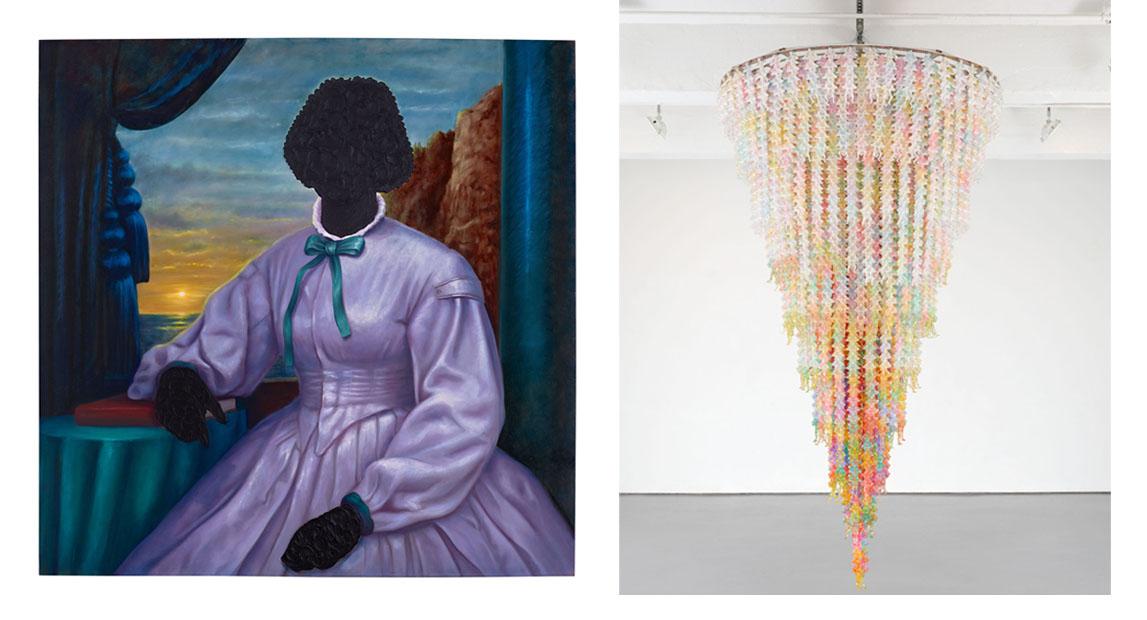Stanford, CA—With the recent acquisition of the painting, Page 4 of Jefferson’s “Farm Book” . . ., by Titus Kaphar, and the monumental hanging sculpture, Cause & Effect, by Do Ho Suh, the Cantor Arts Center at Stanford University has added two significant works to its collection that reference how forced and unforced global migration transform personal and cultural identity.
The acquisition of these works supports the vision of Susan Dackerman, the John and Jill Freidenrich Director of the Cantor, to bring the museum firmly into the 21st century through acquisitions, exhibitions, and programs that feature concerns relevant to the everyday lives of students and other visitors. “I think art, artists, and art history have the potential to challenge a culture’s preconceived notions of itself and enlighten us to other ways of understanding the world,” she said. “Having these art works at the museum will enable us to have conversations about difficult topics from multiple points of view.”
Page 4 is what Kaphar calls a “visual reparation,” and belongs to a series of tar portraits imagining enslaved sitters as freed men and women. By representing them in historical dress reflective of a status above the one they lived, Kaphar visually frees his sitter from enslavement. The face of the subject is obscured by the use of tar, which suggests the sitter’s invisibility. “Kaphar’s artistic practice actively engages with art history in order to investigate its representational inequities, with regard to both what is represented, and who is doing the representing,” said Aleesa Alexander, assistant curator of American art.
In the case of Page 4, the painting was created with specific reference to Thomas Jefferson’s “Farm Book,” which contains lists of Jefferson’s slaves, many identified only by their first names. While Kaphar’s style references the traditional genre of portraiture, his methods of addressing the canvas’s surface—through cutting, nailing, and covering his figures with tar—is decidedly contemporary. “Given that Stanford was also built on a farm, and that the Stanfords employed Chinese laborers, having this piece in our collection will generate interesting parallels worthy of exploration and discussion,” said Alexander. Page 4 is the first work by Kaphar to enter the Cantor’s collection and will be on display in the exhibition The Medium Is the Message: Art since 1950 February 23–August 18, 2019.
Cause & Effect is composed of hundreds of small, colorful, acrylic figures, which form a monumentally-scaled, cone-shaped chandelier suspended from the ceiling and reaching almost to the floor. The interconnectedness of the figures, which sit upon each other’s shoulders, suggest the weight and inescapability of one’s history. Suh’s work, which often references domestic architecture and decoration, questions cultural and aesthetic differences between his native Korea and his adopted homes in the United States and Europe. “Adding this visually compelling and complex work to our collection will allow us to continue to have important discussions about transnational identity and how we comprehend the past while living in the present,” Dackerman said.
“Cause & Effect is a bold and important work, signaling the Cantor’s commitment to exhibit more works of contemporary art by artists from Asia,” said Padma D. Maitland, Patrick J. J. Maveety Assistant Curator of Asian Art. This is the first work by Suh to be added to the Cantor’s collection and is on display with two other works by the artist in the exhibition Do Ho Suh: The Spaces in Between.
The Cantor Arts Center gratefully acknowledges support from the Patricia Geary Johnson Fund for Asian Art Acquisition and the Palmer Gross Ducommun Fund.
Image captions L-R:
Titus Kaphar (U.S.A., b. 1976), Page 4 of Jefferson's "Farm Book," January 1774, Goliath, Hercules, Jupiter, Gill, Fanny, Ned, Sucky, Frankey, Gill, Nell, Bella, Charles, Jenny, Betty, June, Toby, Duna (sic), Cate, Hannah, Rachael, George, Ursula, George, Bagwell, Archy, Frank, Bett, Scilla, ? , 2, 2018. Oil on canvas on support panel. © Titus Kaphar. Palmer Gross Ducommun Fund, 2018.102
Do Ho Suh (South Korea, b. 1962), Cause & Effect, 2007. Acrylic, aluminum disc, stainless steel frame, stainless steel cable, andmonofilament. © Do Ho Suh. Patricia Geary Johnson Fund forAsian Art Acquisition, 2019.1

